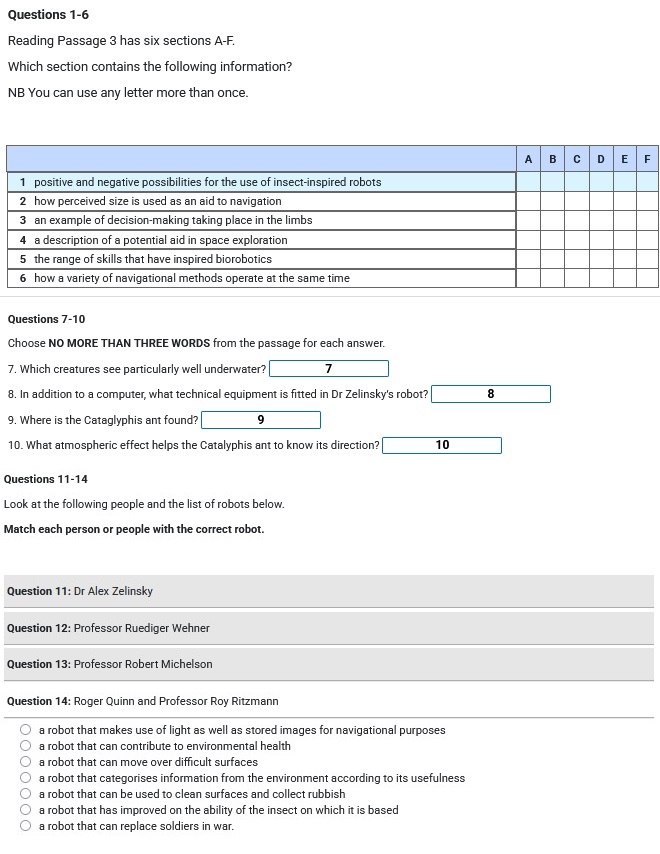Reading Passage 3: https://englishups.com/tests/ielts-reading-3-insect—inspired-robots-1219
Insect – inspired robots
A.
A tiny insect navigates its way across featureless salt-pans. A cockroach successfully works out how to scramble over an obstacle. The mantis shrimp scans its aquatic world through hyperspectral eyes. Using the most basic of equipment and brains tinier than a pinhead, insects constantly solve complex problems of movement, vision and navigation processing data that would challenge a supercomputer. How they do it is driving one of the most exciting new fields of technology-biomimetics and biorobotics, the imitation of insect systems to control man-made machines. Delegates at a recent conference presented some outcomes of their work in this area.
B.
Dr Alex Zelinsky suggested that the method by which wasps use landmarks to find their way back to the nest may one day be part of a system for navigating cars that ‘know’ where to go. A research team led by Dr Zelinsky has shown that a robot can navigate its way along 50 different landmarks by recognizing them individually using a panoramic camera. ‘The inspiration came from biology, where wasps use a practice called “turn back and look” to orient themselves as they emerge from its nest. By flying to and fro, they lock in images of the nest so they can recognize it again,’ he explained. The robot’s panoramic camera logs the surrounding area and its key landmarks, which are then sorted in its computer according to how reliable they are as navigational aids. The landmarks are then scaled, from small to large, so that the robot can recognize whether it is getting closer to or further away from them. Their location is built into a map in its ‘mind’, which operates at different scales and instructs the robot whether to turn left or right at a particular mark. The technology provides a general way for a machine to navigate an unknown landscape.The ant also has a way of measuring distance traveled, while a ‘path integrator’ periodically informs the ant of its current position relative to its point of departure. Rather than integrate all the information it receives in its brain, the ant actually performs a number of complex calculations in different organs. Like a supercomputer, the ant has many separate subroutines going on simultaneously. Using the ant’s ability to steer by polarised light and to store and reuse landscape images, Wehner and colleagues have built ‘Sahabot’, a small vehicle that uses polarisers and a digital CCD camera to store 3600 images of landmarks to the ones in its memory.
C.
For three decades, Professor Ruediger Wehner has journeyed from Switzerland to the Sahara desert where Catalyphis, a tiny ant with a brain weighing just 0.1 mg, performs acts of navigational genius when it leaves its nest, forages for food and returns successfully. Cataglyphis uses polarised light, caused when air molecules scatter light, to orient and steer itself. Wehner’s team found the ant has a set of specialized photoreceptors along the upper rim of its eyes that detect polarized light, while other receptors perform different navigational tasks. As the sun moves, the ant notes its direction each time it leaves the nest and updates its internal compass. Using other eye receptors it stores a ‘snapshot’ image of landmarks, close to the nest entrance in its eyes and compares this with what it sees as it returns.
D.
Professor Robert Michelson had a different desert challenge – to design a flying robot that can not only navigate but also stay aloft and hover in the thin atmosphere of Mars. Drawing inspiration from insect flight, he has gone beyond nature to devise a completely new concept for a flying machine. The ‘Entomopter’ is sort of double-ended dragonfly whose wings beat reciprocally. Michelson says that the flapping-wing design gives the craft unusually high lift compared with a fixed-wing flyer, enabling it to fly slowly or hover in the thin Martain air whereas a fixed-wing craft would have to move at more than 400 km/h and could not stop to explore.
E.
Engineer Roger Quinn and entomologist Professor Roy Ritzmann are taking their inspiration from cockroaches. According to Quinn and Ritsmann, the ability of cockroaches to run very fast over rough terrain may one day give rise to a completely new all-terrain vehicle with six-legs, or maybe even wheel-like legs call ‘whegs’. The key to the cockroach’s remarkable cross-country performance lies partly in the fact that its legs do a lot of the ‘thinking’ without having to consult the brain. Quinn and Ritzmann are drawing on cockroach skills to create robotic walkers and control strategies that capture the remarkable capacity of these insects to traverse complex terrain and navigate safety toward goals while avoiding obstacles. The team has already designed a series of robots that run on six legs or on whegs, enabling them to handle surprisingly rugged terrain.
F.
International experts believe there are tremendous opportunities biorobotics. However, delegates at the conference had differing visions for the future of the science. While some were concerned that the initial applications of biorobotics may be military, others, such as Dr barbara Webb, predicted swarms of tiny cheap insect-like robots as society’s cleaners and collectors. Sonja Kleinlogel hoped the study of the hyperspectral eyes if the mantis shrimp might yield remote sensors that keep watch over the environmental health of our oceans. Several delegates were concerned about the ethical implications of biorobotics, and urged that close attention be paid to this as the science and technologies develop.

Check the answers here: https://englishups.com/tests/ielts-reading-3-insect—inspired-robots-1219